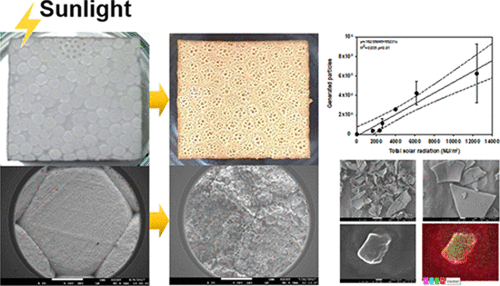当前位置:
X-MOL 学术
›
Environ. Sci. Technol.
›
论文详情
Our official English website, www.x-mol.net, welcomes your
feedback! (Note: you will need to create a separate account there.)
Rapid Production of Micro- and Nanoplastics by Fragmentation of Expanded Polystyrene Exposed to Sunlight.
Environmental Science & Technology ( IF 10.8 ) Pub Date : 2020-08-12 , DOI: 10.1021/acs.est.0c02288 Young Kyoung Song 1 , Sang Hee Hong 1, 2 , Soeun Eo 1, 2 , Gi Myung Han 1 , Won Joon Shim 1, 2
Environmental Science & Technology ( IF 10.8 ) Pub Date : 2020-08-12 , DOI: 10.1021/acs.est.0c02288 Young Kyoung Song 1 , Sang Hee Hong 1, 2 , Soeun Eo 1, 2 , Gi Myung Han 1 , Won Joon Shim 1, 2
Affiliation

|
Expanded polystyrene (EPS) is a common plastic marine debris found in oceans worldwide. The unique “foamed” structure of EPS, which is composed of thin layers, is more vulnerable to fragmentation than bulk plastics. However, the production rate of micro- and nanoplastics by the fragmentation of EPS following sunlight exposure remains largely unknown. Here, we determined the fragmentation rate and weight loss of EPS in an outdoor weathering experiment that ran for 24 months. It took only 1 month for the weight of an EPS box to decline by 5% due to photodegradation, and approximately 6.7 × 107 micro- and nanoparticles/cm2 could be produced at a latitude of 34 °N. These results indicate that macro EPS debris can continually produce a massive number of particles within a relatively short exposure duration. The findings provide useful information to inform policymakers how rapidly to remove “likely fragmented” plastic litter from the environment.
中文翻译:

通过使暴露在阳光下的膨胀聚苯乙烯破碎,可以快速生产微米和纳米塑料。
膨胀聚苯乙烯(EPS)是一种在世界范围内的海洋中发现的常见塑料海洋垃圾。EPS的独特“发泡”结构由薄层组成,比散装塑料更容易碎裂。然而,在阳光暴晒后,EPS碎裂产生的微塑料和纳米塑料的生产率仍然未知。在这里,我们在进行了24个月的户外风化实验中确定了EPS的破碎率和重量损失。由于光降解作用,EPS盒的重量仅用了1个月就下降了5%,并且微米和纳米颗粒/ cm 2约为6.7×10 7可以在34°N的纬度下生产。这些结果表明,宏EPS碎片可以在相对较短的持续时间内连续产生大量颗粒。研究结果为决策者提供了有用的信息,可帮助他们迅速从环境中清除“可能零散的”塑料垃圾。
更新日期:2020-09-15
中文翻译:

通过使暴露在阳光下的膨胀聚苯乙烯破碎,可以快速生产微米和纳米塑料。
膨胀聚苯乙烯(EPS)是一种在世界范围内的海洋中发现的常见塑料海洋垃圾。EPS的独特“发泡”结构由薄层组成,比散装塑料更容易碎裂。然而,在阳光暴晒后,EPS碎裂产生的微塑料和纳米塑料的生产率仍然未知。在这里,我们在进行了24个月的户外风化实验中确定了EPS的破碎率和重量损失。由于光降解作用,EPS盒的重量仅用了1个月就下降了5%,并且微米和纳米颗粒/ cm 2约为6.7×10 7可以在34°N的纬度下生产。这些结果表明,宏EPS碎片可以在相对较短的持续时间内连续产生大量颗粒。研究结果为决策者提供了有用的信息,可帮助他们迅速从环境中清除“可能零散的”塑料垃圾。











































 京公网安备 11010802027423号
京公网安备 11010802027423号